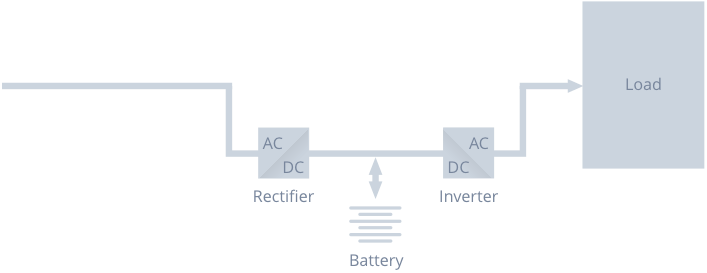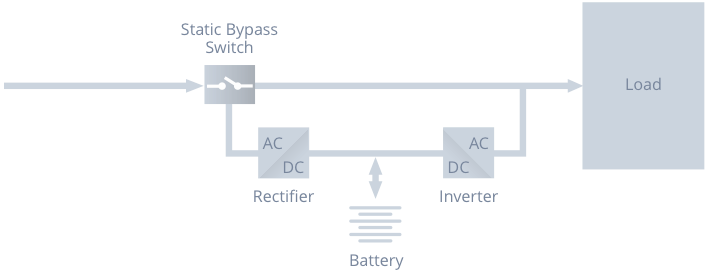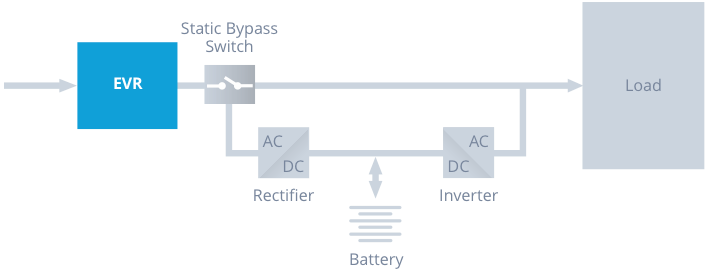System Configuration Schematics
Traditional

In a traditional UPS backup system, all incoming power is routed through the UPS rectifier, which converts power from AC to DC. It is then routed back from DC to AC through the UPS inverter. Through this process, power quality is assured, but electrical efficiency is greatly reduced.
Eco-Mode-Equipped

An eco-mode-equipped UPS backup system increases electrical efficiency by enabling a monitored bypass, which must be custom programmed on a per-installation basis for proper sensitivity to electrical ‘events,’ such as sags, surges, brownouts and blackouts. Due to complex configuration issues and limited reliability data, facility managers rarely enable the eco-mode feature.
EVR-Protected

In an EVR-protected UPS backup system, incoming power is monitored by an EVR, which compensates for voltage fluctuations. In this configuration, power anomalies are conditioned within one cycle, and the static switch is rarely triggered. This leaves the UPS in safe standby mode, unstressed. This system offers a level of electrical efficiency identical to an eco-mode-equipped UPS at a much lower risk level. More importantly, the reliability of an EVR-protected system exceeds that of a traditionally configured system.
UPS systems rarely achieve the levels of electrical efficiency manufacturers advertise. An Emerson study [4] notes that ‘nameplate’ ratings, which are often 96% or better, are based upon full-load efficiency, not typcial use. Emerson suggests using 92% as a standard for calculation. For this comparison, we use 93%, which we believe is a conservative calculation standard.
The charts and graphs included in this article are calculated based upon electricity cost of 10¢ per kwh @ 93% efficiency. Using this figure (which is conservative relative to the 20¢ or more common in urban areas), and comparing a traditional UPS running at 93% efficiency verses an EVR-protected UPS running at 99% efficiency at a 500kVA data center, the differential cost due to electrical inefficiency is $26,280 per year, or $262,800 over the expected 10-year lifespan of a power-backup system.
Cost of Unplanned Outages Due to UPS Failure
The “2013 Cost of Data Center Outages” [5] study, conducted by the Ponemon Institute on behalf of Emerson Network Power, concluded that 15.8% of unplanned outage costs are due to UPS system failure, while a complementary survey of data center professionals6 lists UPS failure as the cause of nearly 25% of unplanned outages.
The same study reports that the average cost per unplanned outage is $690,204 for a data center averaging 12,558 square feet. Normalizing this data for a 500kVA installation (approximately one-fifth the size of the average data center surveyed by Ponemon), we estimate the cost of an unplanned outage at $137,403.
UST estimates that at least half of these UPS-related outages, and perhaps as many as 90%, could be avoided if these relatively fragile systems were not required to operate as frequently. Using the more conservative 50% figure, over a typical 10-year lifespan, the cost savings from a reduction in unplanned outages at a 500kVA data center equals the cost of a single outage times the number of expected outages (1.58 to 2.5) divided by 2 (the number of UPS-related outages mitigated by an EVR).
Based upon this formula, we compute the cost of unplanned power outages (that could be prevented by the inclusion of an EVR at a 500kVA installation) to be between $108,548 and $171,754 over 10 years.
Maintenance and Other Potential Cost Factors
To fully compensate for unplanned outages due to UPS failure at data centers, the literature suggests significantly supplementing manufacturer-recommended maintenance schedules, or even installing expensive redundant systems. However, the addition of an EVR, which would reduce wear and tear on the UPS system, should allow facility mangers to confidently implement a less-costly maintenance schedule.
While battery replacement costs remain flat, based upon customer history, UST believes scheduled maintenance costs could be reduced by as much as 17%, or $2,000 per year, per 500kVA installation.
EVR and Additional Component Costs
Of course, an automatic voltage regulator (along with a static switch and other hardware required to integrate the system) increases the initial cost of a power-backup and power-management system. However, when the cost of unplanned outages and lifetime maintenance are factored in, the total cost of ownership of an EVR-protected system over 10 years is significantly less than all other options, including a comparably sized eco-mode-equipped and enabled UPS.
Next: 10-Year Total Cost of Ownership




